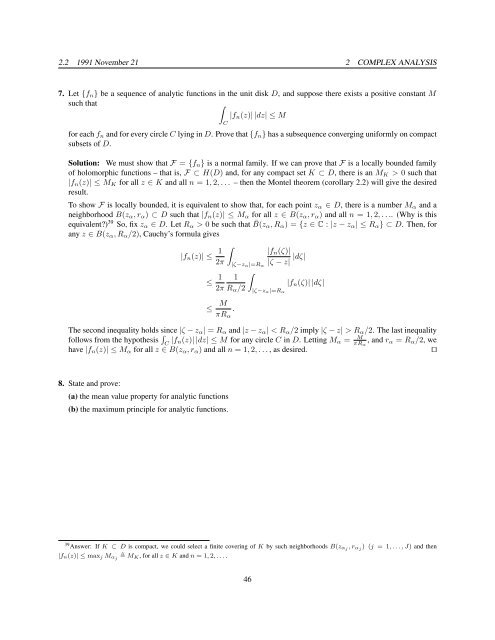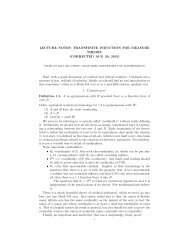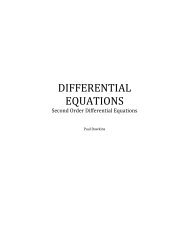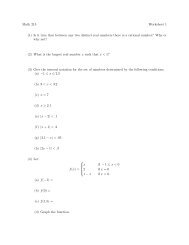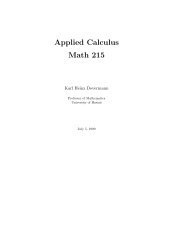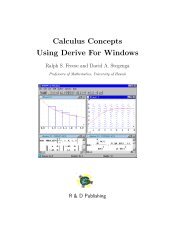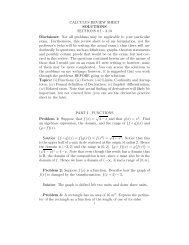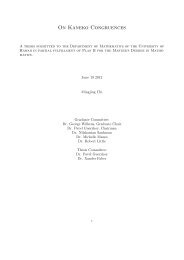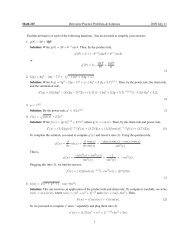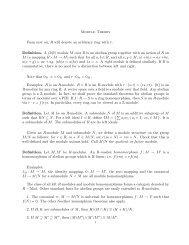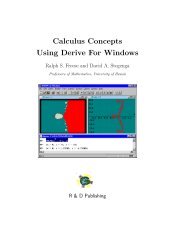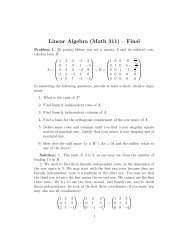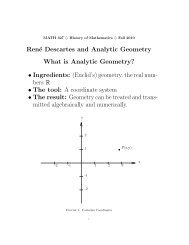Problems and Solutions in - Mathematics - University of Hawaii
Problems and Solutions in - Mathematics - University of Hawaii
Problems and Solutions in - Mathematics - University of Hawaii
Create successful ePaper yourself
Turn your PDF publications into a flip-book with our unique Google optimized e-Paper software.
2.2 1991 November 21 2 COMPLEX ANALYSIS<br />
7. Let {fn} be a sequence <strong>of</strong> analytic functions <strong>in</strong> the unit disk D, <strong>and</strong> suppose there exists a positive constant M<br />
such that <br />
|fn(z)| |dz| ≤ M<br />
C<br />
for each fn <strong>and</strong> for every circle C ly<strong>in</strong>g <strong>in</strong> D. Prove that {fn} has a subsequence converg<strong>in</strong>g uniformly on compact<br />
subsets <strong>of</strong> D.<br />
Solution: We must show that F = {fn} is a normal family. If we can prove that F is a locally bounded family<br />
<strong>of</strong> holomorphic functions – that is, F ⊂ H(D) <strong>and</strong>, for any compact set K ⊂ D, there is an MK > 0 such that<br />
|fn(z)| ≤ MK for all z ∈ K <strong>and</strong> all n = 1, 2, . . . – then the Montel theorem (corollary 2.2) will give the desired<br />
result.<br />
To show F is locally bounded, it is equivalent to show that, for each po<strong>in</strong>t zα ∈ D, there is a number Mα <strong>and</strong> a<br />
neighborhood B(zα, rα) ⊂ D such that |fn(z)| ≤ Mα for all z ∈ B(zα, rα) <strong>and</strong> all n = 1, 2, . . .. (Why is this<br />
equivalent?) 39 So, fix zα ∈ D. Let Rα > 0 be such that ¯ B(zα, Rα) = {z ∈ C : |z − zα| ≤ Rα} ⊂ D. Then, for<br />
any z ∈ B(zα, Rα/2), Cauchy’s formula gives<br />
|fn(z)| ≤ 1<br />
<br />
|fn(ζ)|<br />
2π |ζ−zα|=Rα |ζ − z| |dζ|<br />
≤ 1 1<br />
2π Rα/2<br />
≤ M<br />
.<br />
πRα<br />
<br />
|ζ−zα|=Rα<br />
|fn(ζ)| |dζ|<br />
The second <strong>in</strong>equality holds s<strong>in</strong>ce |ζ − zα| = Rα <strong>and</strong> |z − zα| < Rα/2 imply |ζ − z| > Rα/2. The last <strong>in</strong>equality<br />
follows from the hypothesis <br />
C |fn(z)| |dz| ≤ M for any circle C <strong>in</strong> D. Lett<strong>in</strong>g Mα = M<br />
πRα , <strong>and</strong> rα = Rα/2, we<br />
have |fn(z)| ≤ Mα for all z ∈ B(zα, rα) <strong>and</strong> all n = 1, 2, . . . , as desired. ⊓⊔<br />
8. State <strong>and</strong> prove:<br />
(a) the mean value property for analytic functions<br />
(b) the maximum pr<strong>in</strong>ciple for analytic functions.<br />
39 Answer: If K ⊂ D is compact, we could select a f<strong>in</strong>ite cover<strong>in</strong>g <strong>of</strong> K by such neighborhoods B(zαj , rα j ) (j = 1, . . . , J) <strong>and</strong> then<br />
|fn(z)| ≤ maxj Mα j MK, for all z ∈ K <strong>and</strong> n = 1, 2, . . . .<br />
46


